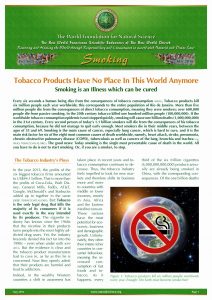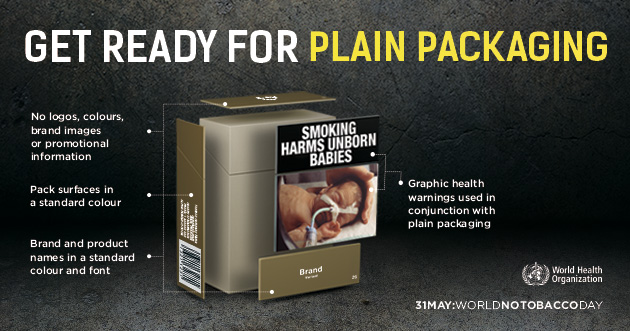Plain tobacco packaging or standardised packaging means the removal of all branding (colours, imagery, corporate logos and trademarks) from the pack. Manufacturers are only allowed to print the brand name at a prescribed size, font and place on the pack, in addition to the health warnings and any other legally mandated information.1
Why plain packaging? Primarily, plain packaging reduces the attractiveness of tobacco products, limits the use of tobacco packaging as a form of advertising, reduces misleading labelling and thus is an important demand reduction measure.
For ‘World No Tobacco Day’, 31st May 2016, the World Health Organisation and the Secretariat of the WHO Framework Convention on Tobacco Control are calling on countries to get ready for plain (standardized) packaging of tobacco products.2
Australia introduced plain or standard packaging in December 2012. In 2014, the number of Australians over 14 who smoked daily dropped from 15.1% to 12.8% between 2010 and 2013, equivalent to a 15% reduction according to Australian government statistics. Although other factors are likely to have contributed to the drop, this was the only intervention policy introduced within the study period.3
Ireland has become in this month of May 2016 the second country in the world to introduce plain packaging. “Standardized packaging will strip away the illusions created by shiny, colourful cigarette packages and replace them with shocking images showing the real consequences of smoking,” said Dr James Reilly, Minister for Children and Youth Affairs.4 Ireland has the vision of a tobacco-free country by 2025; currently tobacco consummation is responsible for one in five deaths in Ireland, i.e. 5,200 deaths every year.
The UK Government has also introduced plain packaging into the UK this month after four tobacco companies lost a legal challenge in the High Court just a few days ago. Mr Justice Green stated in his written ruling: “The essence of the case is about whether it is lawful for states to prevent the tobacco industry from continuing to make profits by using their trade marks and other rights to further what the World Health Organisation describes as a health crisis of epidemic proportions and which imposes an immense clean-up cost on the public purse.” And: “In my judgment the regulations are valid and lawful in all respects.”5
France, which has one of the highest smoking rates in Europe – 32 per cent of men and 26 per cent of women – passed a law at the end of 2015 prescribing plain packaging for cigarette packages, too. After proposing the legislation in 2014, health minister Marisol Touraine emphasised that “we can’t accept that tobacco kills 73,000 people every year in our country – the equivalent of a plane crash every day with 200 people on board.”6
Since May 20th 2016 in the whole European Union, two thirds of the front and back side of cigarette packets have to be covered with shock pictures, and cigarettes with aromas like chocolate and vanilla, reducing the bitter taste of the tobacco7, are forbidden as they are especially seducing the youth.
However, there are still countries that are far behind. Switzerland is still an Eldorado for tobacco companies.8 There are tobacco products that can be manufactured in Switzerland but are not allowed to be either produced or sold in the EU. For instance, cigarettes that contain more than 10 milligrams of tar, more than 1 milligram of nicotine and more than 10 milligrams of carbon monoxide. Even though they cannot be sold in Switzerland, they can be produced and exported. The multinational tobacco industry in Switzerland sold cigarettes to the approximate value of 522 million Swiss francs (about US$500 million) in 2015 – ten years ago sales were 380 million Swiss francs! – which is about the same amount as the export of cheese! Plain packaging is not on the agenda in Switzerland because the Swiss Government compromised on behalf of the tobacco lobby. Compared to other countries in Europe, the situation regarding tobacco advertising is scandalous and only similar to Bulgaria and Andorra; all other nations have distinctly more restrictions.9
 Of course, plain packaging is just one more step towards a tobacco-free world; however, a very important one. You can find fact-based information about the nefarious sale strategies of the tobacco companies, the manifold effects of smoking on our health and also very useful, potentially life-saving information about quitting smoking in our brand new English Fact Sheet “Tobacco Products Have No Place In This World Anymore”.
Of course, plain packaging is just one more step towards a tobacco-free world; however, a very important one. You can find fact-based information about the nefarious sale strategies of the tobacco companies, the manifold effects of smoking on our health and also very useful, potentially life-saving information about quitting smoking in our brand new English Fact Sheet “Tobacco Products Have No Place In This World Anymore”.
The rates of smoking definitely have to decline, and preferably very fast, because there is evidence that smoking has a detrimental effect not only on health and health costs but also at a social and educational level. In a recent study in France, with a sample of 5,221 primary school children, it was shown beyond any doubt that children who have been exposed to smoke prior to or after birth, are more aggressive, disobedient, and betray and lie more than children who were not exposed to smoke.10 And this is just the tip of the iceberg. Simply put, tobacco products are a worldwide individually and socially deadly and unacceptable nuisance and should be eliminated as fast as possible.
1 https://en.wikipedia.org/wiki/Plain_tobacco_packaging
2 http://www.who.int/campaigns/no-tobacco-day/2016/en/
3 http://www.gponline.com/smoking-rates-drop-introduction-plain-packaging-research-shows/article/1304671
4 http://www.who.int/fctc/implementation/news/news_ire/en/
5 http://www.bbc.co.uk/news/uk-36333450
6 http://www.theverge.com/2016/4/4/11345936/france-plain-cigarette-pack-law
7 http://www.tobaccopreventioncessation.com/pdf-63328-4544?filename=Welcoming%20the.pdf
8 http://www.srf.ch/news/wirtschaft/die-schweiz-ist-ein-eldorado-fuer-tabakkonzerne
9 http://www.blick.ch/news/schweiz/eu-fuehrt-schockbilder-auf-zigi-paeckli-ein-das-waere-in-der-schweiz-laengst-faellig-id5058632.html
10 http://journals.plos.org/plosone/article?id=10.1371/journal.pone.0133604









